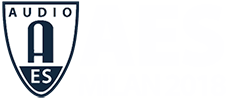AES Milan 2018
Paper Session P01
P01 - Loudspeakers-Part 1
Wednesday, May 23, 09:30 — 12:30 (Scala 4)
Chair:
Angelo Farina, Università di Parma - Parma, Italy
P01-1 Maximizing Efficiency in Active Loudspeaker Systems—Wolfgang Klippel, Klippel GmbH - Dresden, Germany
Increasing the efficiency of the electro-acoustical conversion is the key to modern audio devices generating the required sound output with minimum size, weight, cost, and energy. There is unused potential for increasing the efficiency of the electro-dynamical transducer by using a nonlinear motor topology, a soft suspension, and cultivating the modal resonances in the mechanical and acoustical system. However, transducers optimized for maximum efficiency are more prone to nonlinear and unstable behavior. Nonlinear adaptive control can compensate for the undesired signal distortion, protect the transducer against overload, stabilize the voice coil position, and cope with time varying properties of the suspension. The paper discusses the design of modern active systems that combine the new opportunities provided by software algorithms with the optimization of the hardware components in the transducer and power amplifier.
Convention Paper 9908 (Purchase now)
P01-2 How Do We Make an Electrostatic Loudspeaker with Constant Directivity?—Tim Mellow, Mellow Acoustics Ltd - Farnham, Surrey, UK
The idea of broadening the directivity pattern of a push-pull electrostatic loudspeaker by partitioning the stators into concentric annular rings, which are connected to tappings along a delay line, isn't new. However, the delay line has traditionally been attenuated to avoid response irregularities due to the finite size of the membrane. An alternative approach is presented here whereby a constant-impedance delay line is configured to imitate an oscillating sphere, which is an ideal constant-directivity dipole source that needs no attenuation. Walker's equation for the on-axis pressure does not account for the effect of the delay line without taking the vector sum of the currents though all the rings, so a simple alternative that does is presented here.
Convention Paper 9909 (Purchase now)
P01-3 Analysis of Front Loaded Low Frequency Horn Loudspeakers—Bjørn Kolbrek, Celestion International Ltd. - Ipswich, UK
The low frequency horn design procedures described by Keele and Leach are extended and generalized to cases where the horn is already specified, or where maximum output or the smoothest response is desired. The impact of finite-length horns is analyzed. A more detailed analysis of the high frequency range is given, where it is shown how the voice coil inductance can be taken into account to create a third order low pass filter of specified shape. A new analysis of reactance annulling is presented that significantly improves the performance above cutoff for a certain class of horns. Large signal behavior is touched upon, and finally, an analysis of the sensitivity of driver and system parameters is given.
Convention Paper 9910 (Purchase now)
P01-4 Design and Implementation of a High Efficiency Subwoofer—Sebastian Tengvall, Technical University of Denmark - Kgs. Lyngby, Denmark; Niels Elkjær Iversen, Technical University of Denmark - Kogens Lyngby, Denmark; Arnold Knott, Technical University of Denmark - Kgs. Lyngby, Denmark
The demand for battery driven loudspeakers is increasing but the challenge of efficient low frequency reproduction remains. An alternative approach to the conventional 4th order bandpass enclosure design for a subwoofer to achieve a high peak in the passband and increase voltage sensitivity is investigated. The response is corrected with DSP to ensure a flat response in the passband. The results proved that this approach can increase the voltage sensitivity dramatically, reaching an average sensitivity of over 100 dB in the passband from 45 Hz to 90 Hz. It also showed that the design is sensitive to construction errors. Precise assembling is required to achieve satisfactory results while small errors can ruin the purpose of the design.
Convention Paper 9911 (Purchase now)
P01-5 Parameterization of Micro Speakers Used in Cell Phones and Earbuds—Jason McIntosh, SAATI SPA - Appiano Gentile (C0), Italy
Loudspeaker parameterizations based on measuring a transfer matrix is presented. This approach produces nine complex frequency dependent functions. While Thiele-Small parameters only capture the first piston mode of a moving coil speaker, the transfer matrix approach captures all the linear behavior of the speaker, including the diaphragm modes and internal geometry. Predictions of baffled response of two speakers are presented with the transfer matrix parameters producing better results than the Thiele-Small parameters, especially at high frequencies. The SAATI "Ares" acoustic simulator uses the transfer matrix parameters for effective simulation of complete devices, including proper porting geometry and dampening acoustic meshes for better audio tuning.
Convention Paper 9912 (Purchase now)
P01-6 A Fast And Efficient Model for Transmission Line Loudspeakers—James Hipperson, University of Salford - Salford, UK; Jamie Angus, University of Salford - Salford, Greater Manchester, UK; JASA Consultancy - York, UK; Jonathan Hargreaves, University of Salford - Salford, UK
Transmission Line loudspeakers use a tube behind the driver that is lined, or filled, with absorber to remove the rear radiation. They also use the resonances of the pipe to support the radiation of the driver and reduce displacement at low frequencies. While lumped element models are used for modeling sealed and vented box enclosures, they cannot be used for transmission line loudspeakers because they cannot be accurately modeled as a lumped element. Finite Element and Boundary Element models can be used but they are complex and computationally expensive. A cascaded two port method has been developed that can model varying tube area and absorption. It has been evaluated against acoustic measurements and shown to provide accurate predictions.
Convention Paper 9913 (Purchase now)
